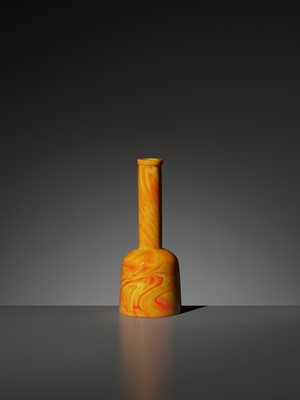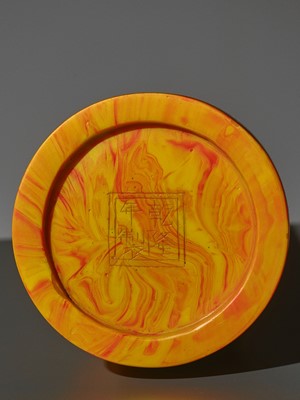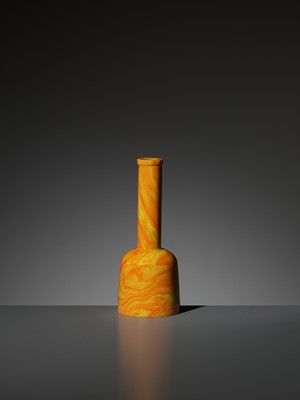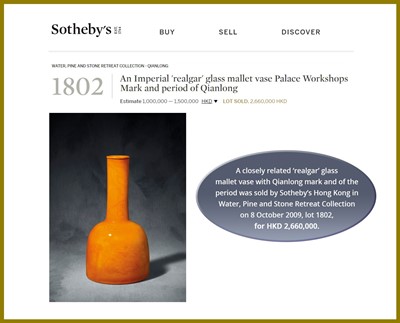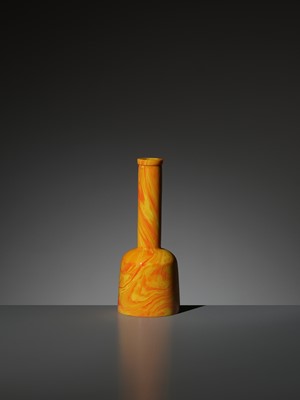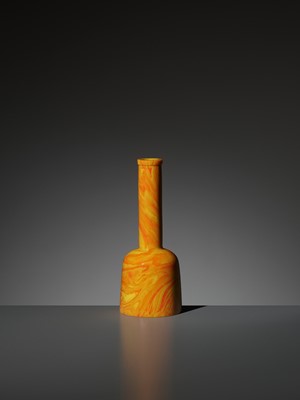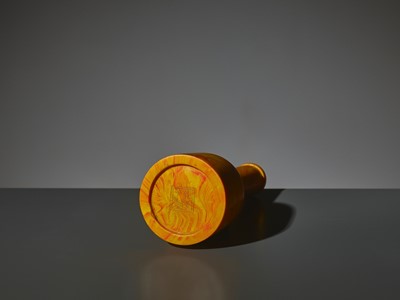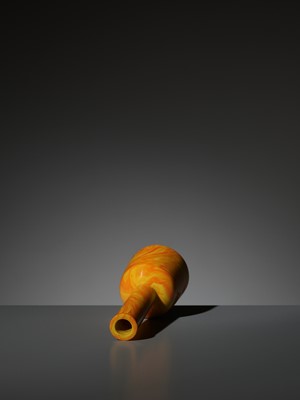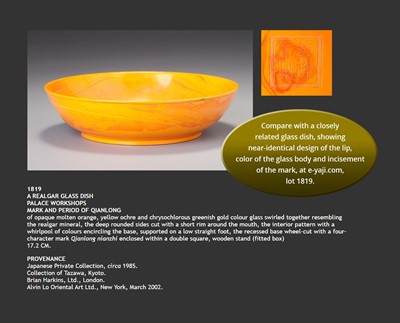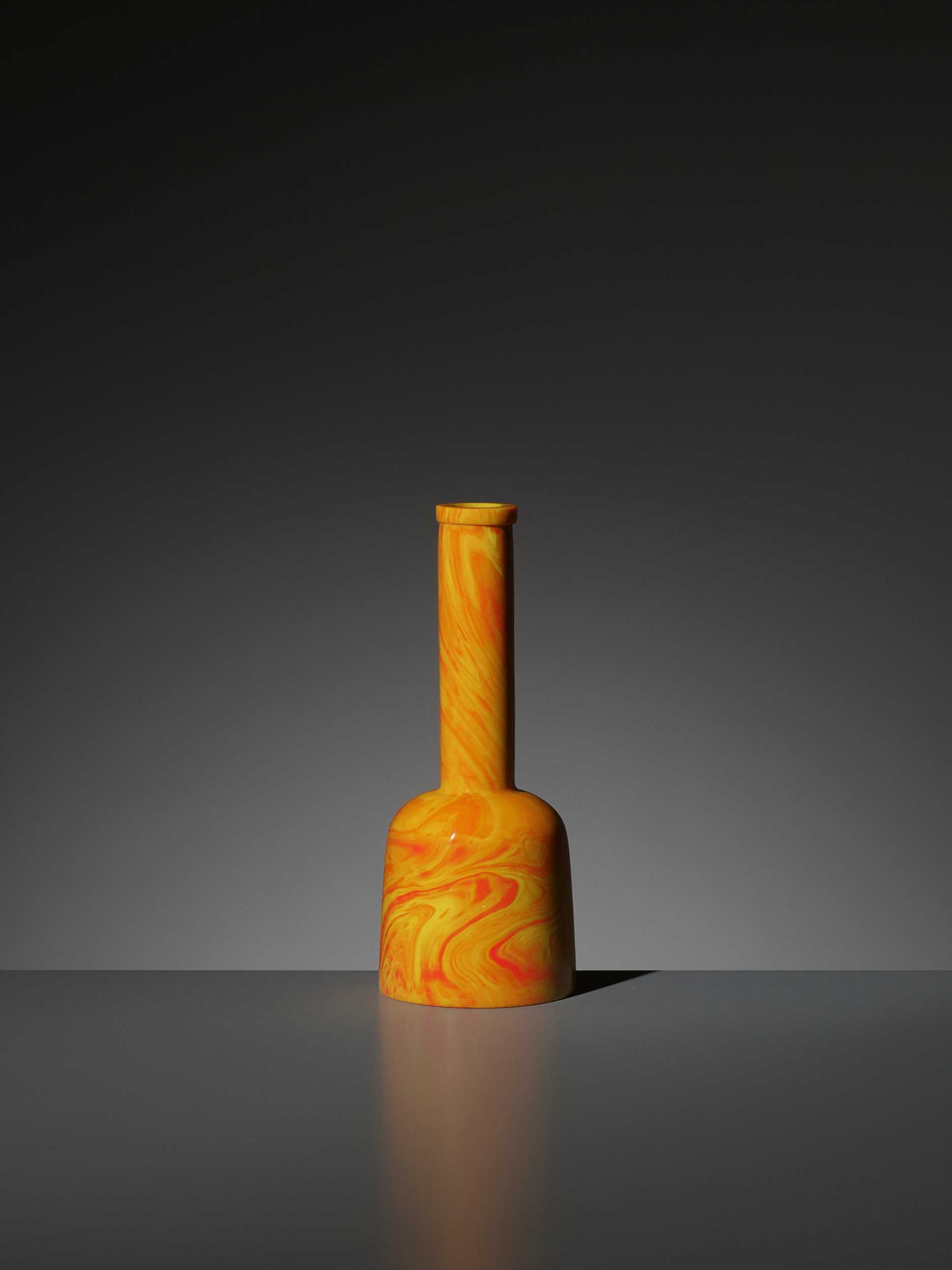5th Mar, 2021 10:00
TWO-DAY AUCTION - Fine Chinese Art / 中國藝術集珍 / Buddhism & Hinduism
15
AN IMPERIAL ‘REALGAR’ GLASS MALLET VASE, QIANLONG MARK AND PERIOD
乾隆款與年代御制雄黃色料馬蹄式瓶
Sold for €9,480
including Buyer's Premium
China, 1735-1796. Swirled together of brilliant, fiery orange and yellow-ochre opaque glass to resemble the realgar mineral, the body of beehive-domed form rising to a slender cylindrical neck with a straight rim. The recessed foot rim with a wheel-cut four-character Qianlong reign mark enclosed within a double square.
Provenance: An old estate in Boston, Massachusetts. A notable US private collection, acquired from the above.
Condition: Very good condition with minor wear, two minuscule chips around the foot rim.
Weight: 341.1 g
Dimensions: Height 15.6 cm
The naturalistic pattern achieved on realgar glass makes vessels of this type attractive and unique. Hugh Moss and Gerard Tsang in Arts from the Scholar's Studio, op. cit., p. 126, note that the “swirling patterns visible at the surface of this vessel are full of possibilities for the imaginative mind. It may read as a landscape, drifting incense smoke or a variety of strange living creatures, but it also represents the endlessly changing patterns of energy from which all phenomena emanate in the Chinese view, particularly expressed by Daoism. To the Daoist scholar it would be a work of art of subtle complexity and endless fascination, to be enjoyed like incense smoke as a meditative aid.”
Realgar (xiong huang), found in the southern provinces of China, was believed to contain the essence of gold and, possibly for this reason, became a source of fascination despite its poisonous qualities. It is believed that it was mixed in drugs used by Daoists in their quest for the elixir of immortality. It is the Daoist alchemy that made realgar popular to the extent that despite the material's highly toxic nature and its soft crumbly texture, which does not lend itself to the artisans' tools without great difficulties, realgar was used for the carving of Daoist figures. For example, a realgar sculpture of the Immortal He Xian Gu, in the British Museum, London, is illustrated in R. Soame Jenyns, Chinese Art, The Minor Arts, II, London, 1965, pl. 200.
The attractiveness of realgar inspired copies to be made in glass such as the present vase. Richard John Lynn in 'Technical aspects and Connoisseurship of Snuff Bottles: Late Traditional Chinese Sources', JICSBS, Summer, 1995, p. 8, mentions Zhou Jixu, a late Qing connoisseur, who believed that realgar glass was among the earliest types of glass made at the Qing Imperial Glassworks. For this reason, the dating of the present vase can probably be narrowed to ca. 1740-1750.
Qianlong mallet form glass vases were inspired by Yongzheng period prototypes. See a blue glass vase published in Zhongguo jin yin boli falang qi quanji, vol. 4, Shijiazhuang, 2004, pl. 154. For the origins of the mallet form, see a Northern Song dynasty (960-1127) celadon vase illustrated in Sekai toji zenshu, vol. 12, Tokyo, 1977, pl. 207, and another published in Longquan Celadon of China, Hong Kong, 1998, pl. 90.
Literature comparisons: A similar vase of smaller size, with its realgar-colored surface decorated with irregular red and yellow veins, as seen on the present vase, bearing a four-character Qianlong reign mark on the base, from the Qing Court collection and still in Beijing, is illustrated in Luster of Autumn Water, Glass of the Qing Imperial Workshop, Beijing, 2005, pl. 25, and also in Zhongguo jin yin boli falang qi quanji, vol. 4, Shijiazhuang, 2004, pl. 216. For further examples of realgar glass vessels see a hexafoil vase, from the Sloane Collection in Jenyns, op.cit., pl. 81, together with a snuff bottle, pl. 201f. A bottle attributed to the Palace Workshop, the body suffused with patches of bright red and yellow, is illustrated in Chinese Snuff Bottles from the Burghley House Collection, Stamford, England, Hong Kong, 1989, pl. 5. Also compare with a closely related glass dish, showing near-identical design of the lip, color of the glass body and incision of the mark, at e-yaji.com, lot 1819.
Auction result comparison: A closely related ‘realgar’ glass mallet vase with Qianlong mark and of the period was sold by Sotheby’s Hong Kong in Water, Pine and Stone Retreat Collection on 8 October 2009, lot 1802, for HKD 2,660,000.
乾隆款與年代御制雄黃色料馬蹄式瓶
中國,1735-1796。花瓶色澤明亮,艷麗的橙色和黃色不透明料間雜旋轉而成,猶如雄黃,蜂巢狀的主體,頸部呈細長圓柱形,邊緣筆直。圈足内凹,雙方框四字乾隆款。
來源:波斯頓一個老遺產。美國貴族私人收藏,購於上述遺產。
品相:狀況極好,輕微磨損,圈足上兩処細微磕碰。
重量:341.1 克
尺寸:高15.6 厘米
乾隆時期的料器瓶受雍正時期風格影響。《中國金銀玻璃琺琅器全集》第四冊(石家莊,2004年,圖154)中的藍色料器瓶。馬蹄形瓶原可見Sekai toji zenshu第十二冊(東京, 1977, 圖 207)中記載的北宋 (960-1127) 青瓷瓶和另一件記載于《中國龍泉青瓷》(香港,1998,圖 90)。
文獻比較:一件相似馬蹄瓶,尺寸稍小,雄黃色表面呈不規則紅黃色經絡紋,底足亦有乾隆四字款,來自清王室收藏,仍留在北京,記載于Luster of Autumn Water. Glass of the Qing Imperial Workshop, Beijing, 2005, 圖 25;在《中國金銀玻璃琺琅器全集》第四冊(石家莊,2004年,圖216)。其他雄黃料器如一個六角玻璃瓶,來自Sloane Collection in Jenyns, op.cit., 圖81, 與一個鼻烟壺,圖201f. 一個記爲御制鼻烟壺,表面紅黃色塊,記載在Chinese Snuff Bottles from the burghley House Collection, Stamford, England, Hong Kong, 1989, 圖 5。
拍賣結果比較:一件相近的乾隆款與年代的雄黃色馬蹄瓶,售于香港蘇富比Water, Pine and Stone Retreat Collection 拍場,2009年10月8日,lot 1802,售價HKD 2,660,000。
China, 1735-1796. Swirled together of brilliant, fiery orange and yellow-ochre opaque glass to resemble the realgar mineral, the body of beehive-domed form rising to a slender cylindrical neck with a straight rim. The recessed foot rim with a wheel-cut four-character Qianlong reign mark enclosed within a double square.
Provenance: An old estate in Boston, Massachusetts. A notable US private collection, acquired from the above.
Condition: Very good condition with minor wear, two minuscule chips around the foot rim.
Weight: 341.1 g
Dimensions: Height 15.6 cm
The naturalistic pattern achieved on realgar glass makes vessels of this type attractive and unique. Hugh Moss and Gerard Tsang in Arts from the Scholar's Studio, op. cit., p. 126, note that the “swirling patterns visible at the surface of this vessel are full of possibilities for the imaginative mind. It may read as a landscape, drifting incense smoke or a variety of strange living creatures, but it also represents the endlessly changing patterns of energy from which all phenomena emanate in the Chinese view, particularly expressed by Daoism. To the Daoist scholar it would be a work of art of subtle complexity and endless fascination, to be enjoyed like incense smoke as a meditative aid.”
Realgar (xiong huang), found in the southern provinces of China, was believed to contain the essence of gold and, possibly for this reason, became a source of fascination despite its poisonous qualities. It is believed that it was mixed in drugs used by Daoists in their quest for the elixir of immortality. It is the Daoist alchemy that made realgar popular to the extent that despite the material's highly toxic nature and its soft crumbly texture, which does not lend itself to the artisans' tools without great difficulties, realgar was used for the carving of Daoist figures. For example, a realgar sculpture of the Immortal He Xian Gu, in the British Museum, London, is illustrated in R. Soame Jenyns, Chinese Art, The Minor Arts, II, London, 1965, pl. 200.
The attractiveness of realgar inspired copies to be made in glass such as the present vase. Richard John Lynn in 'Technical aspects and Connoisseurship of Snuff Bottles: Late Traditional Chinese Sources', JICSBS, Summer, 1995, p. 8, mentions Zhou Jixu, a late Qing connoisseur, who believed that realgar glass was among the earliest types of glass made at the Qing Imperial Glassworks. For this reason, the dating of the present vase can probably be narrowed to ca. 1740-1750.
Qianlong mallet form glass vases were inspired by Yongzheng period prototypes. See a blue glass vase published in Zhongguo jin yin boli falang qi quanji, vol. 4, Shijiazhuang, 2004, pl. 154. For the origins of the mallet form, see a Northern Song dynasty (960-1127) celadon vase illustrated in Sekai toji zenshu, vol. 12, Tokyo, 1977, pl. 207, and another published in Longquan Celadon of China, Hong Kong, 1998, pl. 90.
Literature comparisons: A similar vase of smaller size, with its realgar-colored surface decorated with irregular red and yellow veins, as seen on the present vase, bearing a four-character Qianlong reign mark on the base, from the Qing Court collection and still in Beijing, is illustrated in Luster of Autumn Water, Glass of the Qing Imperial Workshop, Beijing, 2005, pl. 25, and also in Zhongguo jin yin boli falang qi quanji, vol. 4, Shijiazhuang, 2004, pl. 216. For further examples of realgar glass vessels see a hexafoil vase, from the Sloane Collection in Jenyns, op.cit., pl. 81, together with a snuff bottle, pl. 201f. A bottle attributed to the Palace Workshop, the body suffused with patches of bright red and yellow, is illustrated in Chinese Snuff Bottles from the Burghley House Collection, Stamford, England, Hong Kong, 1989, pl. 5. Also compare with a closely related glass dish, showing near-identical design of the lip, color of the glass body and incision of the mark, at e-yaji.com, lot 1819.
Auction result comparison: A closely related ‘realgar’ glass mallet vase with Qianlong mark and of the period was sold by Sotheby’s Hong Kong in Water, Pine and Stone Retreat Collection on 8 October 2009, lot 1802, for HKD 2,660,000.
乾隆款與年代御制雄黃色料馬蹄式瓶
中國,1735-1796。花瓶色澤明亮,艷麗的橙色和黃色不透明料間雜旋轉而成,猶如雄黃,蜂巢狀的主體,頸部呈細長圓柱形,邊緣筆直。圈足内凹,雙方框四字乾隆款。
來源:波斯頓一個老遺產。美國貴族私人收藏,購於上述遺產。
品相:狀況極好,輕微磨損,圈足上兩処細微磕碰。
重量:341.1 克
尺寸:高15.6 厘米
乾隆時期的料器瓶受雍正時期風格影響。《中國金銀玻璃琺琅器全集》第四冊(石家莊,2004年,圖154)中的藍色料器瓶。馬蹄形瓶原可見Sekai toji zenshu第十二冊(東京, 1977, 圖 207)中記載的北宋 (960-1127) 青瓷瓶和另一件記載于《中國龍泉青瓷》(香港,1998,圖 90)。
文獻比較:一件相似馬蹄瓶,尺寸稍小,雄黃色表面呈不規則紅黃色經絡紋,底足亦有乾隆四字款,來自清王室收藏,仍留在北京,記載于Luster of Autumn Water. Glass of the Qing Imperial Workshop, Beijing, 2005, 圖 25;在《中國金銀玻璃琺琅器全集》第四冊(石家莊,2004年,圖216)。其他雄黃料器如一個六角玻璃瓶,來自Sloane Collection in Jenyns, op.cit., 圖81, 與一個鼻烟壺,圖201f. 一個記爲御制鼻烟壺,表面紅黃色塊,記載在Chinese Snuff Bottles from the burghley House Collection, Stamford, England, Hong Kong, 1989, 圖 5。
拍賣結果比較:一件相近的乾隆款與年代的雄黃色馬蹄瓶,售于香港蘇富比Water, Pine and Stone Retreat Collection 拍場,2009年10月8日,lot 1802,售價HKD 2,660,000。
Zacke Live Online Bidding
Our online bidding platform makes it easier than ever to bid in our auctions! When you bid through our website, you can take advantage of our premium buyer's terms without incurring any additional online bidding surcharges.
To bid live online, you'll need to create an online account. Once your account is created and your identity is verified, you can register to bid in an auction up to 12 hours before the auction begins.
Intended Spend and Bid Limits
When you register to bid in an online auction, you will need to share your intended maximum spending budget for the auction. We will then review your intended spend and set a bid limit for you. Once you have pre-registered for a live online auction, you can see your intended spend and bid limit by going to 'Account Settings' and clicking on 'Live Bidding Registrations'.
Your bid limit will be the maximum amount you can bid during the auction. Your bid limit is for the hammer price and is not affected by the buyer’s premium and VAT. For example, if you have a bid limit of €1,000 and place two winning bids for €300 and €200, then you will only be able to bid €500 for the rest of the auction. If you try to place a bid that is higher than €500, you will not be able to do so.
Online Absentee and Telephone Bids
You can now leave absentee and telephone bids on our website!
Absentee Bidding
Once you've created an account and your identity is verified, you can leave your absentee bid directly on the lot page. We will contact you when your bids have been confirmed.
Telephone Bidding
Once you've created an account and your identity is verified, you can leave telephone bids online. We will contact you when your bids have been confirmed.
Classic Absentee and Telephone Bidding Form
You can still submit absentee and telephone bids by email or fax if you prefer. Simply fill out the Absentee Bidding/Telephone bidding form and return it to us by email at office@zacke.at or by fax at +43 (1) 532 04 52 20. You can download the PDF from our Upcoming Auctions page.
How-To Guides
How to Create Your Personal Zacke Account
How to Register to Bid on Zacke Live
How to Leave Absentee Bids Online
How to Leave Telephone Bids Online
中文版本的操作指南
创建新账号
注册Zacke Live在线直播竞拍(免平台费)
缺席投标和电话投标
Third-Party Bidding
We partner with best-in-class third-party partners to make it easy for you to bid online in the channel of your choice. Please note that if you bid with one of our third-party online partners, then there will be a live bidding surcharge on top of your final purchase price. You can find all of our fees here. Here's a full list of our third-party partners:
- 51 Bid Live
- EpaiLive
- ArtFoxLive
- Invaluable
- LiveAuctioneers
- the-saleroom
- lot-tissimo
- Drouot
Please note that we place different auctions on different platforms. For example, in general, we only place Chinese art auctions on 51 Bid Live.
Bidding in Person
You must register to bid in person and will be assigned a paddle at the auction. Please contact us at office@zacke.at or +43 (1) 532 04 52 for the latest local health and safety guidelines.
